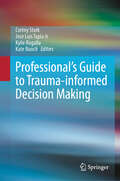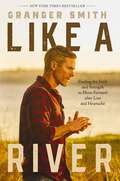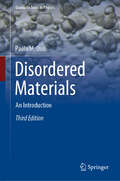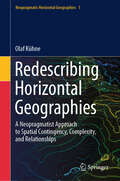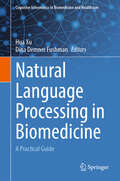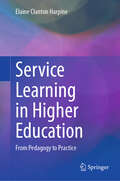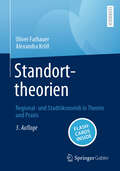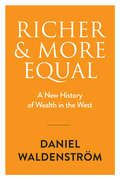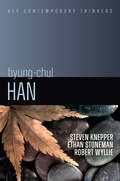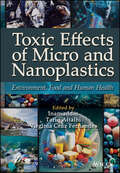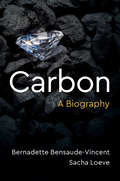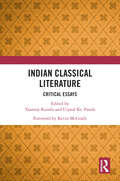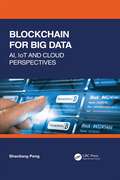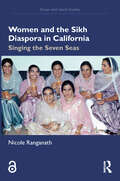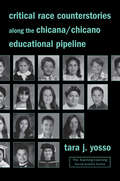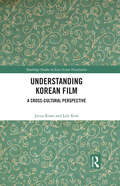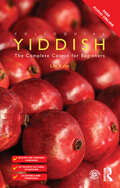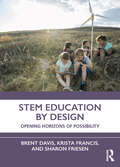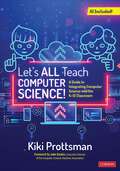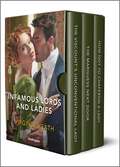- Table View
- List View
Professional's Guide to Trauma-informed Decision Making
by Cortny Stark Jose Luis Tapia Jr. Kylie Rogalla Kate BunchProfessional’s Guide to Trauma-informed Ethical Decision Making offers helping professionals a framework comprising the 10 Principles of Trauma-informed Ethical Practice (Stark, Tapia-Fuselier, & Bunch, 2022) enhanced with prominent ethical decision making models. These principles build upon the SAMHSA (2014) conceptualization of trauma-informed care, address key concepts such as Adverse Childhood Experiences (ACEs) and their long-term impact, marginalization stress, the influence of military and law enforcement experience, and others. Despite distinctions between the diversity of helping professions (in credentials, scope of practice, and theoretical approach), the same decision making models for trauma-informed care is a requirement for best practice. Thus, this volume is designed to address the needs of professionals serving diverse clientele, particularly those who’ve experienced trauma and adversity. Practitioners may utilize this text to as a guide to assistwith ethical decision making when working with client survivors of trauma, and educators may select this text as required reading to support the development of trauma-informed clinicians-in-training.
Like a River: Finding the Faith and Strength to Move Forward after Loss and Heartache
by Granger SmithNew York Times, USA Today, Wall Street Journal, Publishers Weekly, ECPA Bestseller'Country music artist Smith debuts with a sensitive and moving recollection of his path through grief. . .In stark, intimate prose, the author candidly renders the realities of suffering while articulating a moving message of renewal. Those seeking a faith-based path through grief will find this instructive and affecting.' -- Publishers WeeklyLike a River, a triumphant story of new life birthed out of tragedy, will teach readers how to face their failures, confront their pain, and connect with God—the true source of life.On June 4th, 2019, country music singer Granger Smith was enjoying a final evening with his kids before heading to Nashville for the CMT Music Awards and his next tour. While helping his daughter London with her gymnastics, his youngest son fell into their pool. Granger did everything he could to get to him, but he was too late. River drowned, and Granger's world shattered.The days, weeks, and months that followed River's death sent Granger on a dark and painful journey. Every time he closed his eyes, he replayed the horrific event in his mind, and every time he opened his computer, he was bombarded by the critique and criticism of people who blamed him for the accident.Despite his best effort to get back on stage with a smile and song, it was all a façade. On the inside he was dying. Fortunately, that's not how his story ended. And now he is compelled to help people all around the world find strength, peace, and hope on the other side of tragedy.Like a River, life is full of twists and turns.Like a River, people pollute our world with their critique and criticism.Like a River, tragic events keep us dammed up.But like a river, we can find the courage to keep moving downstream. Rivers don't run on their own strength; they flow from their source. When we try to keep going on our own, we won't make it, but when we connect to the greater source, we will find the strength and the faith to keep living after loss. This triumphant story of new life birthed out of death will inspire every reader to live Like a River.
Disordered Materials: An Introduction (Graduate Texts in Physics)
by Paolo M. OssiThis self-contained textbook takes readers on a comprehensive journey through the intricate realm of physics in structurally disordered condensed materials. Tailored for advanced undergraduate and graduate students, this book unfolds the complexities step by step. In this updated and enlarged 3rd edition, fundamental building blocks serve as the foundation for constructing structural models of disordered solids, delving into their geometry and symmetry. The scope of the book encompasses the phenomenology and various models of the glass transition, elucidating the characteristics of bulk metallic glasses. Structural analysis techniques for amorphous solids, the role of atomic clusters in structure evolution, quasicrystals, nanometer-sized disordered solids, cluster-assembled materials, and the synthesis and assembly of nanoparticles are explored. The text also navigates through the intricacies of transport and localization in heavily disordered materials, offering insights into controlled growth of thin films. Throughout, the narrative is enriched with references to recent and pertinent results, both experimental and theoretical, providing readers with a gateway to the latest and most dynamic research areas in the field.
Redescribing Horizontal Geographies: A Neopragmatist Approach to Spatial Contingency, Complexity, and Relationships (Neopragmatic Horizontal Geographies #1)
by Olaf KühneThe first book in the series provides the concept of a theoretical redefinition of 'horizontal geographies'. These denote the spatial syntheses as undertaken in various disciplines, whether as regional studies, area studies, new regional geography, and many more. The basis of the redescription is philosophical neopragmatism, which has occasionally been taken up in the spatial sciences, but has never been differentiated into a theory-driven empirical research program. This development of the research program guides the present book. Philosophical neopragmatism, especially as conceptualized by Richard Rorty, focuses in particular on contingency of society, self, and language, which also allows spatial syntheses to be understood not as 'images of reality' but as contingent proposals for redescribing spaces. As a result of the complexity of spatial processes, their horizontal geographic study requires a triangulation of theories, methods, researcher perspectives, data, and the involvement of people without expert special knowledge. To highlight the contingency of the spatial syntheses, the presentation of the results - —here especially graphic and cartographic - —resorts to the attitude of irony. Regarding the six levels of trigangulation, neopragmatism acts as a meta-theoretical orientation framework. Against the background of the complexity of spatial developments on the one hand and to operationalize Rorty's principle of private self-creation and public solidarity on the other hand, Ralf Dahrendorf's concept of life chances is drawn upon. Especially in the differentiation of this concept made in this book, it serves on the one hand for an understanding access of the (also spatial) expression of options and ligatures,, and on the other hand it offers a normative framework for the evaluation of socio-spatial developments. The reference to neopragmatic studies on spatial syntheses conducted to date and evaluated in this book shows the potential of the approach elaborated here in conceptual detail for the first time.
Natural Language Processing in Biomedicine: A Practical Guide (Cognitive Informatics in Biomedicine and Healthcare)
by Hua Xu Dina Demner FushmanThis textbook covers broad topics within the application of natural language processing (NLP) in biomedicine, and provides in-depth review of the NLP solutions that reveal information embedded in biomedical text. The need for biomedical NLP research and development has grown rapidly in the past two decades as an important field in cognitive informatics. Natural Language Processing in Biomedicine: A Practical Guide introduces the history of the biomedical NLP field and takes the reader through the basic aspects of NLP including different levels of linguistic information and widely used machine learning and deep learning algorithms. The book details common biomedical NLP tasks, such as named entity recognition, concept normalization, relation extraction, text classification, information retrieval, and question answering. The book illustrates the tasks with real-life use cases and introduces real-world datasets, novel machine learning and deep learning algorithms, and large language models. Relevant resources for corpora and medical terminologies are also introduced. The final chapters are devoted to discussing applications of biomedical NLP in healthcare and life sciences. This textbook therefore represents essential reading for students in biomedical informatics programs, as well as for professionals who are conducting research or building biomedical NLP systems.
Service Learning in Higher Education: From Pedagogy to Practice
by Elaine Clanton HarpineThis practical guide assists university faculty in developing and implementing service-learning courses and projects across multiple disciplines. It examines how embedding academic service-learning projects into the core curricula benefits not only the students, but also their universities and communities. The book describes ways in which service learning becomes a powerful teaching method using step-by-step explanations, real-world examples, and instructor checklists and handouts. Chapters detail how to integrate academic service-learning projects into classroom pedagogy and evaluate student experience.Key areas of coverage include:Strategies for ensuring that students engage with academic service-learning projects from the initial stages through completion.Guidance on embedding an academic service-learning curriculum into traditional coursework to supplement students’ textbook knowledge and classroom experiences to address real-world problems in the community.Research confirming the ways in which students learn more and score higher on end-of-the-semester tests when courses incorporate academic service-learning projects.Steps to incorporate service-learning projects across various disciplines and coursework to enrich student learning and produce positive outcomes for universities and communities. Service Learning in Higher Education is an essential resource for professors and graduate students as well as teachers and educational professionals in such varied fields as school and clinical child psychology, educational psychology, social work, pedagogy, educational practice and policy, sociology, anthropology, and all related disciplines.
Textbook of Dermatologic Ultrasound
by Ximena WortsmanThis book provides a pedagogical guide to dermatologic ultrasound. As in any imaging field, dermatologic ultrasound is dynamic, and the area expands with the release of new technology. This textbook is a mix of the essential knowledge necessary to start and a detailed update to the dermatologic ultrasound field. This book is divided into three sections: The Requisites, Ultrasound Features of Common Dermatologic Conditions, and Practicalities. The first section details the basic information needed in dermatologic ultrasound, including technical recommendations and dermatologic concepts. The second covers major dermatologic conditions and their ultrasound presentation, including benign and malignant skin tumors, pediatric conditions, nail entities, inflammatory conditions, infections and infestations, and aesthetics. The final section covers tips for reporting and interventional dermatologic ultrasound procedures.Chapters present substantial clinical, ultrasonographic, and histologic correlation, including algorithms to help discriminate different conditions. The book additionally includes 150 self-assessment questions (CME), multiple key points, a plethora of state-of-the-art images with probes that go from 18 to 70 MHz, and ultrasound videos. This is a must guide for physicians, residents, and students in radiology, dermatology, plastic surgery, and any professional who wants to brush up on the dermatologic ultrasound field.
Standorttheorien: Regional- und Stadtökonomik in Theorie und Praxis
by Alexandra Kröll Oliver FarhauerDas Buch stellt sowohl traditionelle als auch neuere und neueste Theorien zur Standortwahl vor. Die traditionellen Standorttheorien umfassen die klassische Standortlehre, die Agglomerationsökonomik sowie die Untersuchung der Effekte unterschiedlicher Branchenstrukturen auf eine Stadt oder Region. Daneben werden neuere Ansätze wie die Cluster- und Netzwerktheorie von Michael Porter und neueste Erklärungsmodelle wie die Neue Ökonomische Geographie und die Theorie der Kreativen Klasse präsentiert. Sie alle machen Gründe für die räumliche Ballung wirtschaftlicher Aktivität anschaulich. Damit der Leser regional- und stadtökonomische Untersuchungen (z.B. im Rahmen von Seminar- und Abschlussarbeiten, Kurzanalysen etc.) selbst durchführen kann, wird auch Wissen über die empirische Methodik vermittelt. So werden verschiedenste Maße der räumlichen Konzentration und regionalen Spezialisierung vorgestellt sowie die Durchführung einer Shift-Share- und Input-Output-Analyse demonstriert.DasLehrbuch zeichnet sich durch seine besondere didaktische Aufbereitung aus: So werden Gleichungen in den theoretischen Kapiteln stets ausführlich interpretiert, damit der Gedankengang dahinter ersichtlich wird. Auf diese Weise streben die Autoren an, dem Leser die Scheu vor komplexeren Modellen oder auch nur „umständlich“ aussehenden Formeln zu nehmen. Neu in der 3. Auflage: Testen Sie Ihr Wissen mit Fragen und Antworten zum Buch in der Springer Nature Flashcards-App!
How Should Netflix Add an Ad-Supported Tier?
by Elie Ofek Olivier ToubiaIn the summer of 2022, it became clear that Netflix would introduce an ad-supported tier alongside its existing subscription plans in the near future. Speculation abounded as to the details of the new tier: How many minutes of advertising would it include? What picture quality would it offer? How many screens could be viewed at the same time? And, critically, how much would it cost the consumer per month? In this exercise, students are tasked with trying to assess whether Netflix should indeed go ahead with introducing a new ad-supported tier - and if so, how? - or whether the company would be better off sticking with its existing tiers and repricing them - and if so, by how much? Students need to evaluate which of these options would maximize the number of subscribers, and importantly, profits. Students have at their disposal results from market research (specifically a conjoint analysis study), financial reports, and industry data. The exercise also allows for a conceptual discussion of the merits of alternative revenue models: ad-driven vs. pure subscription-driven vs. a hybrid of the two.
Hot Wheels: Launching The Mixed Play Experience
by Elie Ofek Nicole Tempest Keller Andres TerechChris Down, Global Brand General Manager for Hot Wheels, and his team from the Advanced Play Group within Mattel, Inc., had developed an entirely new "mixed play" product experience that blended familiar Hot Wheels play in the physical world with breakthrough play in the digital world. The technology underlying the product was an NFC chip embedded in the physical Hot Wheels die-cast car that could be scanned to add a digital version of the car into a virtual domain, where users could see their stats and play video games with the car. The goal for the new mixed play experience was to extend the age of the Hot Wheels customer, as children were observed to be moving on from physical toys to digital play at a younger and younger age. The mixed play concept had received unprecedented investment and support, since it represented a whole new approach to play that could set the stage for the future of Hot Wheels and other Mattel brands. In early 2019, the product development phase was nearly complete and plans were being set for the launch. Key decisions needed to be made around positioning, naming, pricing, channel, promotion, and launch timing. Given the high expectations for the innovative mixed play platform, it was critical to get these go-to-market decisions right.
York Capital and Enovix
by Jo Tango Alys Ferragamo William VrattosIn June 2020, Jeremy Blank prepared for a meeting with his fellow partners at York Capital to discuss an investment he had championed in Enovix, a company developing a state-of-the-art, silicon-based battery. Early-stage technology companies, like Enovix, were not typical investments for York, but Blank had convinced his partners to invest. However, the partnership wanted to be "one and done" without reinvesting in future rounds. By 2020, Enovix had made great progress but not as quickly as forecasted. The company had set out to raise more money and received a term sheet from a well-known publicly-traded company. Blank saw this as an exciting opportunity for Enovix, but he was disappointed to see that it would require York to invest more capital and forego a key protective feature. How should Blank approach this meeting with his partners, and what should he recommend?
Richer and More Equal: A New History of Wealth in the West
by Daniel WaldenströmOnce there were princes and peasants and very few between. The extremes of wealth and poverty are still with us, but that shouldn't blind us to the fact our societies have been utterly transformed for the better over the past century. As Daniel Waldenström makes clear in this authoritative account of wealth accumulation and inequality in the modern west, we are today both significantly richer and more equal. Using cutting-edge research and new, sometimes surprising, data, Waldenström shows that what stands out since the late 1800s is a massive rise in the size of the middle class and its share of society’s total wealth. Unfettered capitalism, it seems, doesn’t have to lead to boundless inequality. The key to progress was political and institutional change that enabled citizens to become educated, better paid, and to amass wealth through housing and pension savings. Waldenström asks how we can consolidate these gains while encouraging the creation of new capital. The answer, he argues, is to pursue tax and social policies that raise the wealth of people in the bottom and middle rather than cutting wealth of entrepreneurs at the top. Richer and More Equal is a benchmark account of one of the most profound and encouraging social changes in human history and a blueprint for continued progress.
Byung-Chul Han: A Critical Introduction (Key Contemporary Thinkers)
by Steven Knepper Ethan Stoneman Robert WyllieByung-Chul Han is one of the most important living philosophers, renowned for his critiques of the digital age. In response to the idea that new technological devices expand our freedom, he argues that they lead to burnout and self-absorption and that we must redevelop contemplative practices which slow us down and open us up. He has brought to his thought forms of deep cosmopolitanism developed from both Zen Buddhism and a renewed Romanticism. This book is the first critical introduction to Han’s body of work. Knepper, Stoneman, and Wyllie explore Han’s rich oeuvre to date and his incisive contributions to a range of disciplines, including critical theory, media studies, political philosophy, and aesthetics. They unpack his key terms and illustrate his concepts with a range of examples, revealing how the critiques of the “achievement society” and burnout, which have earned Han a global audience, build on his earlier accounts of power, violence, and mood. This broader view addresses the most frequent criticisms of Han and makes a compelling case that he is not only an insightful diagnostician of the present moment but one whose interpretation of both Western and Eastern traditions offers wisdom for navigating the now acute problems of modernity. This lively book is essential reading for anyone getting to grips with Han’s extraordinary work.
Toxic Effects of Micro- and Nanoplastics: Environment, Food and Human Health
by Inamuddin Tariq Altalhi Virgínia Cruz FernandesThis book provides in-depth coverage of the sources, dispersion, life cycle assessment strategies, physico-chemical interactions, methods of analysis, toxicological investigation, and remediation strategies of micro and nanoplastics. Micro and nanoplastics are the degradation products of large plastic compounds. These degraded polymers enter into the natural environment, including air, water, and food, which leads to various significant threats to human health. The nature of these micro and nanoplastics is persistent and consequently accumulates in the exposed person’s body. Research into microplastics has shown that these particles accumulate in various human organs and impart detrimental effects on humans. To safeguard human health, analysis and remediation strategies are necessary. This book provides a comprehensive overview in 24 chapters on the source, distribution, life cycle assessment strategies, physico-chemical interactions, methods of analysis, toxicological investigation, and remediation strategies of micro and nanoplastics. Audience This book is a valuable resource for chemists and polymer scientists in various industries including plastics, fisheries, food and beverages, environmental sciences, agriculture, and medicine, as well as government policymakers.
Carbon: A Biography
by Sacha Loeve Bernadette Bensaude-VincentCarbon is much more than a chemical element: it is a polymorphic entity with many faces, at once natural, cultural and social. Ranging across ten million different compounds, carbon has as many personas in nature as it has roles in human life on earth. And yet it rarely makes the headlines as anything other than the villain of our fossil-based economy, feeding an addiction which is driving dangerous levels of consumption and international conflict and which, left unchecked, could lead to our demise as a species. But the impact of CO₂ on climate change only tells part of the story, and to demonize carbon as an element which will bring about the downfall of humanity is to reduce it to a pale shadow of itself. In this major new history of carbon, Bernadette Bensaude-Vincent and Sacha Loeve show that this omnipresent element is at the root of countless histories and adventures through time, thanks to its extraordinary versatility. Carbon has a long and prestigious CV: its work and achievements extend far beyond the burning of fossil fuels. The fourth most abundant element in the universe and the second most abundant element in the human body, carbon is the chemical basis of all known life. Carbon chemistry has a long history, with applications ranging from jewellery to heating, underpinning developments in metallurgy, textiles, pharmaceuticals, electronics, nanoscience and green technologies. A biography of carbon transgresses the boundaries between chemical and social existence, between nature and culture, forcing us to abandon the simplified image of carbon as the anti-hero of human civilization and enabling us to see instead the great diversity of carbon’s modes of existence. With scientific precision and literary flair, Bensaude-Vincent and Loeve unravel the surprising ways in which carbon has shaped our world, showing how unrecognizable the earth would be without it. Uncovering the many hidden lives of carbon allows us to view our own with fresh eyes.
Indian Classical Literature: Critical Essays
by Tanmoy Kundu and Ujjwal Kr. PandaThis book critically analyses classical Indian literature and explores the philosophical, literary, and cultural landscapes which have emerged in response to ancient Indian texts. It highlights the relevance of these texts and studies and how they have come to influence modern Indian literature in various ways. The authors look at classical literature both as a theoretical premise that primarily seeks to develop new knowledge and as a sphere of serious modern/postmodern critical attention. The volume features essays on key texts including Abhijnanasakuntalam, The Cilappatikaram: A Tale of An Anklet, Mrichchakatika, Panchatantra, and Mahabharata.A useful guide to ancient Indian texts, the book will be indispensable for students and researchers of mythology and classical literature, literary and critical theory, Indian literature, Sanskrit studies, and South Asian studies.
Blockchain for Big Data: AI, IoT and Cloud Perspectives
by Shaoliang PengIn recent years, the fast-paced development of social information and networks has led to the explosive growth of data. A variety of big data have emerged, encouraging researchers to make business decisions by analysing this data. However, many challenges remain, especially concerning data security and privacy. Big data security and privacy threats permeate every link of the big data industry chain, such as data production, collection, processing, and sharing, and the causes of risk are complex and interwoven. Blockchain technology has been highly praised and recognised for its decentralised infrastructure, anonymity, security, and other characteristics, and it will change the way we access and share information. In this book, the author demonstrates how blockchain technology can overcome some limitations in big data technology and can promote the development of big data while also helping to overcome security and privacy challenges. The author investigates research into and the application of blockchain technology in the field of big data and assesses the attendant advantages and challenges while discussing the possible future directions of the convergence of blockchain and big data. After mastering concepts and technologies introduced in this work, readers will be able to understand the technical evolution, similarities, and differences between blockchain and big data technology, allowing them to further apply it in their development and research.Author:Shaoliang Peng is the Executive Director and Professor of the College of Computer Science and Electronic Engineering, National Supercomputing Centre of Hunan University, Changsha, China. His research interests are high-performance computing, bioinformatics, big data, AI, and blockchain.
Women and the Sikh Diaspora in California: Singing the Seven Seas (Ocean and Island Studies)
by Nicole RanganathThis book charts the transoceanic history of South Asian women in California through their speech and songs across the twentieth century.Nicole Ranganath reimagines the history of the South Asian diaspora through an examination of gender and the dynamic interplay of water and land in the cultural history of Sikhs, a faith and cultural community that emerged in the Punjab region of north South Asia over 550 years ago. It shows how the history and music of transoceanic communities, in this case Sikhs, spilled beyond the boundaries of regions, empires and nation-states. It emphasizes the heterogeneity of the South Asia diaspora by uncovering the distinct history of women’s migration experiences, as well as an alternative oceanic imaginary among Sikhs that envisions unity in the cosmos. It foregrounds the pivotal role that women played in transforming Sikh communities in California through songs and female affinities. Based on six years of fieldwork in rural northern California, it explores song as a window into the interior lives of Sikh women through their performance of diverse genres: gadar anti-colonial songs, folk music, hymns, and autobiographical songs. This sonic history of South Asian women in the diaspora dislodges dominant paradigms in diaspora studies and oceanic humanities that depict men as mobile and women as stationary.Women and the Sikh Diaspora in California will interest scholars of migration, South Asia and South Asian American studies, oceanic humanities, Sikh studies, music, and women’s studies. It is also essential reading for anyone who is curious about global music and migration, as well as Sikh history.
Critical Race Counterstories along the Chicana/Chicano Educational Pipeline (Teaching/Learning Social Justice)
by Tara J. YossoChicanas/os are part of the youngest, largest, and fastest growing racial/ethnic 'minority' population in the United States, yet at every schooling level, they suffer the lowest educational outcomes of any racial/ethnic group. Using a 'counterstorytelling' methodology, Tara Yosso debunks racialized myths that blame the victims for these unequal educational outcomes and redirects our focus toward historical patterns of institutional neglect. She artfully interweaves empirical data and theoretical arguments with engaging narratives that expose and analyse racism as it functions to limit access and opportunity for Chicana/o students. By humanising the need to transform our educational system, Yosso offers an accessible tool for teaching and learning about the problems and possibilities present along the Chicano/a educational pipeline.
Understanding Korean Film: A Cross-Cultural Perspective (Routledge Studies in East Asian Translation)
by Jieun Kiaer Loli KimFilm viewing presents a unique situation in which the film viewer is unwittingly placed in the role of a multimodal translator, finding themselves entirely responsible for interpreting multifaceted meanings at the mercy of their own semiotic repertoire. Yet, researchers have made little attempt, as they have for literary texts, to explain the gap in translation when it comes to multimodality. It is no wonder then that, in an era of informed consumerism, film viewers have been trying to develop their own toolboxes for the tasks that they are faced with when viewing foreign language films by sharing information online. This is particularly the case with South Korean film, which has drawn the interest of foreign viewers who want to understand these untranslatable meanings and even go as far as learning the Korean language to do so. Understanding Korean Film: A Cross-Cultural Perspective breaks this long-awaited ground by explaining the meaning potential of a selection of common Korean verbal and non-verbal expressions in a range of contexts in South Korean film that are often untranslatable for English-speaking Western viewers. Through the selection of expressions provided in the text, readers become familiar with a system that can be extended more generally to understanding expressions in South Korean films. Formal analyses are presented in the form of in-depth discursive deconstructions of verbal and non-verbal expressions within the context of South Korea’s Confucian traditions. Our case studies thus illustrate, in a more systematic way, how various meaning potentials can be inferred in particular narrative contexts.
Colloquial Yiddish (Colloquial Series)
by Lily KahnSpecially written by an experienced teacher, Colloquial Yiddish offers a step-by-step approach to Yiddish as it is spoken and written today.Colloquial Yiddish provides the first widely available, easily accessible, comprehensive Yiddish course designed primarily for the twenty-first-century international English-speaking independent learner and suitable for use in Yiddish classes worldwide.Each unit presents numerous grammatical points that are reinforced with a wide range of exercises for regular practice. A full answer key can be found at the back as well as useful vocabulary summaries throughout.Key features include: graded development of speaking, listening, reading and writing skills realistic and entertaining dialogues jargon-free and clearly structured grammatical explanations a range of dynamic and appropriate supporting exercises supplementary texts presenting many of the most significant and relevant aspects of Yiddish culture. By the end of this rewarding course you will be able to communicate confidently and effectively in Yiddish in a broad range of situations.Course components:The complete course comprises the book and audio materials. These are available to purchase separately in paperback, ebook, CD and MP3 format. The paperback and CDs can also be purchased together in the great-value Colloquials pack. Paperback: 978-0-415-58019-9 (please note this does not include the audio)CDs: 978-0-415-58020-5eBook: 978-0-203-85120-3 (please note this does not include the audio, available to purchase from http://ebookstore.tandf.co.uk/audio_viewbooks.aspx)MP3s: 978-0-415-58021-2 (available to purchase from http://ebookstore.tandf.co.uk/audio_viewbooks.aspx)Pack: 978-0-415-58022-9 (paperback and CDs)
STEM Education by Design: Opening Horizons of Possibility
by Sharon Friesen Brent Davis Krista FrancisAn accessible text that assumes no prior knowledge, this book is grounded in the realization that "STEM" and "STEM Education" have not yet evolved into fully coherent fields of study, and fills this gap by offering an original model and strategy for developing coherences in a way that both honors the integrity of each of STEM’s constituent disciplines and explores the ways they can amplify one another when used together to address complex contemporary issues. This book demonstrates how STEM can and should be understood as more than a collection of disciplines; it is a transdisciplinary, possibility-rich domain that is much more than the sum of its parts. Building on the actual work of scientists, engineers, and other professionals, the authors disrupt preconceptions about STEM domains, and provide the tools and evidence-based approaches to create new possibilities for all learners. Covering historical influences, theoretical frameworks, and current debates and challenges, this book positions teachers and students as agents of change. Each chapter features In Brief openers to introduce the topic; Opening Anecdotes to reflect the chapter’s key themes; Sidebars to put core principles in context; Consolidating Key Points activities to summarize and highlight important details; and Challenges to build upon and extend topics explored in the chapter from different angles.
Let′s All Teach Computer Science!: A Guide to Integrating Computer Science Into the K-12 Classroom
by Kiki ProttsmanYou belong in this world of computer science education—and because of you, adults of the future will understand how to responsibly participate in high-tech environments with confidence. Districts, cities, and states are moving toward computer science requirements for all K-12 classrooms, even in courses that were not previously associated with technology. These new requirements leave many teachers feeling anxious and unprepared when it comes to integrating computer science into existing curriculum. This book is here to support educators in that shift by inviting them to explore computer science and coding in an approachable and unintimidating way. Let′s All Teach Computer Science: K-12 is a source of inspiration and empowerment for educators who are moving into this technological wonderland. Kiki Prottsman has more than 15 years of experience in computer science education, and her insight informs thoughtful discussions on promoting creativity, problem-solving, and collaboration in students. The book positions computer science in a way that supports other essential skills–such as reading, writing, and mathematics– by providing customizable frameworks that help to seamlessly integrate computer science into core subjects. This book: Provides powerful insights for creating innovative and inclusive learning environments Offers practical examples of integrating computer science into traditional subjects like math, history, art, and more Highlights the importance of addressing implicit biases and promoting computer science as an inclusive field for all students Includes insights on classroom technology and educational technology, as well as AI and its role in education Encourages educators to work together to nurture digital innovators while recognizing potential challenges and frustrations Let′s All Teach Computer Science is an essential guide that equips K-12 teachers with the knowledge and tools necessary to begin teaching computer science immediately–and does so in an enjoyable way, thanks to Prottsman’s friendly and playful style.
Let′s All Teach Computer Science!: A Guide to Integrating Computer Science Into the K-12 Classroom
by Kiki ProttsmanYou belong in this world of computer science education—and because of you, adults of the future will understand how to responsibly participate in high-tech environments with confidence. Districts, cities, and states are moving toward computer science requirements for all K-12 classrooms, even in courses that were not previously associated with technology. These new requirements leave many teachers feeling anxious and unprepared when it comes to integrating computer science into existing curriculum. This book is here to support educators in that shift by inviting them to explore computer science and coding in an approachable and unintimidating way. Let′s All Teach Computer Science: K-12 is a source of inspiration and empowerment for educators who are moving into this technological wonderland. Kiki Prottsman has more than 15 years of experience in computer science education, and her insight informs thoughtful discussions on promoting creativity, problem-solving, and collaboration in students. The book positions computer science in a way that supports other essential skills–such as reading, writing, and mathematics– by providing customizable frameworks that help to seamlessly integrate computer science into core subjects. This book: Provides powerful insights for creating innovative and inclusive learning environments Offers practical examples of integrating computer science into traditional subjects like math, history, art, and more Highlights the importance of addressing implicit biases and promoting computer science as an inclusive field for all students Includes insights on classroom technology and educational technology, as well as AI and its role in education Encourages educators to work together to nurture digital innovators while recognizing potential challenges and frustrations Let′s All Teach Computer Science is an essential guide that equips K-12 teachers with the knowledge and tools necessary to begin teaching computer science immediately–and does so in an enjoyable way, thanks to Prottsman’s friendly and playful style.
Infamous Lords and Ladies: A Regency Romance Collection (The Talk of the Beau Monde)
by Virginia HeathHarlequin Historical brings you three spicy Regency romances in one collection. Follow three unconventional sisters as they meet their matches in three rebellious gentlemen – and become the talk of Society! The Viscount's Unconventional Lady After Lord Eastwood&’s scandalous divorce made him?infamous, he is reluctant to return to London society. To halt the rumor mill, he?should marry?a quiet noblewoman—instead it&’s vibrant artist Faith Brookes who&’s caught his attention. They are the?least suitable match,?so why is he like a moth to a flame? The Marquess Next Door To avoid an unwanted suitor at a ball, Hope Brookes asks another gentleman to rescue her. He obliges—with a surprisingly passionate kiss! He's revealed as her sinfully handsome new neighbor, Lucius, Marquess of Thundersley...? How Not to Chaperon a Lady Chaperoning Charity Brookes while she&’s on a singing tour should be easy for Griffith Philpot—he&’s spent his whole life sparring with her over her flighty ways! But as he discovers that she&’s much more than the impetuous girl he thought he knew, a passion ignites between them… Previously published as: The Talk of the Beau Monde miniseries Three unconventional sisters for three infamous lords Book 1:?The Viscount's Unconventional Lady Book 2:?The Marquess Next Door Book 3:?How Not to Chaperon a Lady
